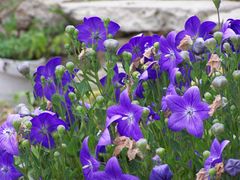Platycodon grandiflorus
| Platycodon grandiflorus subsp. var. | Chinese bellflower, Japanese bellflower, common balloon flower, balloon flower | |||||||||||||||||||||||||||||||||||||||||||||||||||||||
|---|---|---|---|---|---|---|---|---|---|---|---|---|---|---|---|---|---|---|---|---|---|---|---|---|---|---|---|---|---|---|---|---|---|---|---|---|---|---|---|---|---|---|---|---|---|---|---|---|---|---|---|---|---|---|---|---|

|
|
| ||||||||||||||||||||||||||||||||||||||||||||||||||||||
| ||||||||||||||||||||||||||||||||||||||||||||||||||||||||
Platycodon grandiflorus is a species of perennial flowering plant of the family Campanulaceae and the only member of the genus Platycodon (from Greek "πλατυκώδων", meaning 'a broad bell'). This species is known as platycodon or Chinese bellflower. Depending upon the region, it is also referred to as the Japanese bellflower, common balloon flower, or balloon flower. It is native to East Asia (such as China, Korea, Japan, and East Siberia) and bears big blue flowers, although varieties with white and pink flowers are in cultivation. In Korea, white flowers are more common.
The plant is a popular garden ornamental. It is hardy to USDA plant hardiness zone 3 and requires little care.
Cultivation
Propagation
Pests and diseases
Species
Gallery
If you have a photo of this plant, please upload it! Plus, there may be other photos available for you to add.
-
photo 1
-
photo 2
-
photo 3
References
External links
- w:Platycodon grandiflorus. Some of the material on this page may be from Wikipedia, under the Creative Commons license.
- Platycodon grandiflorus QR Code (Size 50, 100, 200, 500)

